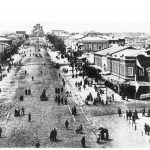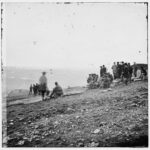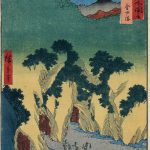
Roger Fenton’s photograph Valley of the Shadow of Death (1855) remains one of the most impactful images in the history of photography and war documentation. This iconic image, taken during the Crimean War, not only showcases the harsh realities of war but also marks a turning point in visual storytelling. Through this photograph, Fenton captured the barren landscape scattered with cannonballs, symbolizing both the danger and desolation experienced by soldiers. This image has inspired countless artists, historians, and journalists by highlighting the profound impact that photography can have on public perception.
Background: Roger Fenton and the Crimean War
Roger Fenton, born in 1819, was one of Britain’s pioneering photographers. His early work focused on landscapes, architecture, and portraiture. However, in 1855, Fenton was commissioned by the British government to document the Crimean War. His task was not to depict the gruesome details of war but to capture images that could boost morale and support for the British forces. Despite this directive, Fenton’s photography showed a raw side of war that the world had rarely seen.
The Crimean War, fought from 1853 to 1856, was one of the first major conflicts in Europe in which photography played a significant role. Fenton’s photographs served as the earliest war images seen by a broad audience, bringing the remote conflict into homes across Europe. Valley of the Shadow of Death stands out as a remarkable piece from this collection, illustrating the toll of war through a hauntingly empty landscape filled only with the remnants of violence.
Composition and Technique: A Study in Atmosphere and Mood
Valley of the Shadow of Death is a stark, minimalistic image that relies on its barren landscape to convey emotion. The photograph was taken in a valley near Sevastopol, Crimea, a location rife with danger, as evidenced by the scattered cannonballs littering the road. The composition is void of soldiers or visible human casualties, yet it captures the grim atmosphere of war through its desolate setting.
Fenton used a large format camera that required long exposure times, making it challenging to capture any moving subjects. This constraint likely influenced his choice of subject matter. His use of light and shadow enhances the sense of isolation, emphasizing the emptiness and quiet devastation of the valley. By placing the cannonballs prominently in the frame, Fenton not only focuses on the remnants of battle but also draws attention to the unyielding brutality of warfare.
Symbolism and Interpretation: An Image Open to Contemplation
One of the remarkable aspects of Valley of the Shadow of Death is its symbolic depth. The empty road, leading into an uncertain distance, can be seen as a metaphor for the dangerous and often futile nature of war. The lack of human presence serves to universalize the image, making it not just a scene from the Crimean War but a representation of all battlefields. The title, drawn from Psalm 23, further imbues the photograph with a somber, almost biblical resonance. By invoking the “shadow of death,” Fenton points to the ever-present danger faced by soldiers and the haunting memory of those who have fallen.
A notable aspect of Fenton’s image is the way it elicits empathy without showing explicit violence. By focusing on the aftermath rather than the combat, Fenton invites viewers to imagine the lives impacted by the war, encouraging a reflective and contemplative response. This approach set a standard for photojournalism that would influence generations to come.
Controversy: The Question of Staged Photography
One of the enduring controversies surrounding Valley of the Shadow of Death is whether Fenton staged the photograph by arranging cannonballs on the road. Scholars and historians have debated this, as there exist two versions of the photograph—one with cannonballs scattered across the road and another with them mostly in the ditch beside it. Some argue that Fenton might have moved the cannonballs to enhance the dramatic effect, an early example of ethical questions surrounding war photography.
If indeed staged, this raises intriguing questions about authenticity and intention in documentary photography. Was Fenton trying to emphasize the dangers faced by soldiers, or was he simply aiming to create a more compelling composition? This debate highlights the delicate balance photographers face in documenting truth while creating impactful images.
Influence on War Photography and Public Perception
Valley of the Shadow of Death has had a lasting impact on war photography, influencing how subsequent conflicts were visually recorded. Fenton’s work paved the way for photographers like Mathew Brady and Alexander Gardner, who documented the American Civil War with similar restraint and compositional elegance. By showing the aftermath rather than the action, Fenton set a standard for respectful, contemplative war photography. His work underscored the potential of photographs to sway public opinion and bring distant realities into sharp focus for viewers around the world.
Legacy: The Enduring Power of Valley of the Shadow of Death
Today, Valley of the Shadow of Death is celebrated as a masterpiece of early photography. The image is preserved in major art institutions and is frequently studied in art and journalism schools as a prime example of documentary photography’s power. Fenton’s photograph reminds viewers that war’s impact lingers long after the fighting ceases. Its subtlety and depth have inspired not only war photographers but also painters, writers, and filmmakers, all of whom continue to explore the visual language of conflict and loss.
In a time when images are instantly shared and consumed, Fenton’s work stands as a reminder of the importance of intentionality and perspective in photography. Valley of the Shadow of Death remains relevant as it resonates with audiences today, offering a profound look at war’s silent echoes.
Key Takeaways
- Valley of the Shadow of Death by Roger Fenton (1855) is one of the first war photographs, taken during the Crimean War.
- Fenton’s photograph captures a desolate valley scattered with cannonballs, symbolizing the dangers faced by soldiers.
- The composition, devoid of human presence, invites viewers to reflect on the universal impact of war.
- Controversy surrounds whether the image was staged, highlighting early debates on authenticity in war photography.
- The photograph set a standard for war photography, influencing generations of photographers and establishing visual norms in conflict documentation.
FAQs
- Why is Valley of the Shadow of Death significant?
- It is one of the earliest war photographs and highlights the silent impact of war through a haunting, empty landscape.
- Did Roger Fenton stage the photograph?
- There is debate among historians about whether Fenton arranged the cannonballs to enhance the dramatic effect.
- How did Valley of the Shadow of Death influence photography?
- It set a standard for respectful, contemplative war photography, influencing photographers like Mathew Brady and Alexander Gardner.




